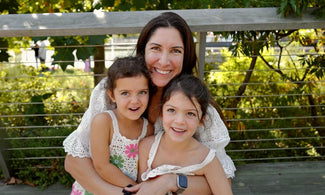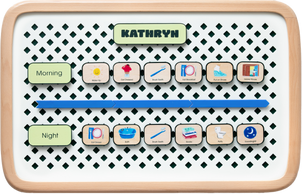Meet the Team: Steph Korey Goodwin
Meet Steph Korey Goodwin, the parent and co-founder behind Charmspring.

If parenting often feels like a “do it yourself” adventure, Charmspring co-founder Steph Korey Goodwin can agree. When her first daughter, Lily, then 2 years old, kept asking, “What’s happening today?” Steph undertook a personal art project “with stick figures showing various activities and a daily calendar from construction paper.” And Lily loved it.
“The explanation of weeks, when school days happen, the difference between weekdays (when Mom and Dad work) and weekends (when it’s 100% family time) fascinated and riveted her,” Steph explains. “She was soaking it all up.”
That was two years ago. Since then, Steph’s at-home project sparked a long journey to creating the Springboard in hopes that routines could be a little more fun (and a lot less crafty) for the whole family. In this interview, Steph shares more about the inspiration and steps she took to bring Charmspring to life!
How did your daughter ultimately help to inspire Charmspring?
When my daughter was 2 (she’s now 4), she would wake up and ask, “What am I doing today?” It (understandably) wasn’t clear to her that her morning wake up and afternoon nap wake ups happened at two different times. She craved knowing if it was breakfast time or school time or time for a different activity. Her little mind was connecting the dots, and she reasonably wanted to know what was coming next.
Knowing this, what did you do to help her figure out her days?
It’s really rudimentary, but I started making stick figures on construction paper for each day. I explained the concepts of weeks and what happened on specific days. The whole thing fascinated and riveted her.
When I tried to find a more permanent solution, I, of course, turned to the internet. Parents online kept saying, “This visual scheduler I made was such a game-changer for my kid! They’re so much happier and excited to understand each day.”
The feedback was so positive. But the only solutions I found online were how-to’s on doing it yourself with clip art, multiple craft-store visits, and a lamination machine. Paper stick figures were kind of my limit! [Laughs]
Since you’re not a DIY parent, what did you do next?
I started finding early childhood resources through our pre-school. They have awesome educational speakers. I learned more about the visual calendar concept through them: how it helps decrease anxiety, increase kids’ independence, improve transitions between activities, and helps impart early childhood development skills like literacy, counting, time keeping, and more.
I knew the visual calendar worked from my own experience, and I knew how to make a product. That need in families’ lives and the gap in the market—knowing parents loved this solution but couldn’t actually buy a permanent, quality product—really sparked this idea of Charmspring. So I ran with it.
How did your work at Warby Parker and Away help you for this next chapter?
Both companies really taught me how to put customers at the center and actually talk to them when it comes to developing products. It doesn’t seem like a revolutionary concept now, but before DTC, the brands making and designing products didn’t have a direct line to customers.
I spoke with 100+ families to understand their routines, weekly activities, and who was involved with childcare. I wanted to help build a visual calendar that would work with any permutation of their lives. I spoke with childhood experts on what issues they were helping families solve and how a product like this could benefit them too.
In the end, we settled on two approaches: a totally custom board where families are picking each and every activity tile or starter packs based on the most common activities for your child’s age. The boards are set up for three different age groups—babies, toddlers, and big kids—since their developmental needs are totally different.
What do parenting and entrepreneurship have in common?
A big part of entrepreneurship is frustration tolerance. So is parenting! [Laughs] Both are really fun. There are so many highs where you feel, “Wow, this is exciting.” Then there are the challenges. Parenting is good practice for handling the tough and unexpected and learning to have a good attitude as you problem solve.
Also similar to raising children, starting a business takes a village. The village you create is the biggest make-or-break thing in that journey. With Charmspring, I’ve been really intentional and amazed with the different people we’ve brought together to work on this. It’s a business where everyone enjoys each others’ company, brings their expertise, does their best work, and has a lot of fun doing it.
If you enjoyed reading about Steph’s journey to creating Charmspring, meet Jennie Monness and Allie Klein, the founding team behind the brand!
Follow Steph Korey Goodwin on Instagram, LinkedIn, X, Crunchbase, Entrepreneur, and Forbes.
